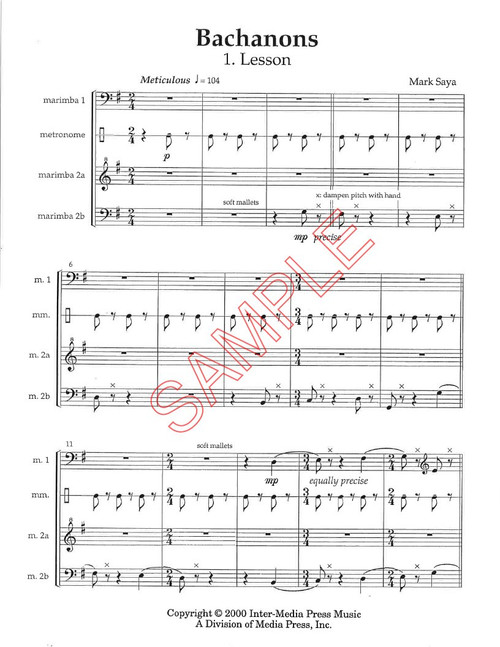For percussion trio, includes score and parts. Based on Johann Sebastian Bach's perpetual puzzle cannons, California composer, Mark Saya has crafted a monumental work for three mallet-keyboard players (Can be performed with four players as well). Duration: ca.. 24'
Want it now? Click here to purchase a digital copy of this product.
Review from Percussive Notes:
|
Bach's music translates easily to many different media. Keyboard percussionists have been performing his music for decades, so it is not surprising that composer Mark Saya used the 14 recently discovered "perpetual puzzle cannons" by Bach as a basis for this chamber percussion work. The original cannons, employing the first eight notes of the ground bass of the Goldberg Variations, are short, repeating fragments that grow in complexity and number of voice parts. Saya has expanded these canons into a 14-movement work for three percussionists playing two marimbas, two to three vibraphones, orchestra bells, celesta, crotales, small ratchet, metronome, large tam-tam and metal whistle. An alternate instrumentation for an ensemble of four players is also included. The movements are extremely well-crafted settings, which are at times wildly creative while staying true to the original character of Bach's work. Saya uses mixed meter to create disjointed rhythmic effects and unusual pauses in the musical flow. This is most effective in the first canon ("Lesson") with its use of a steady metronome click against which the downbeat repeatedly shifts. Movement eight, "Concertina," which features changing meters every measure, is described as being "oddly dancelike, hesitant yet graceful." The result is a kind of "Bach meets Stravinsky" effect that is charming. Shifting tonality is explored in many of the movements. In the second movement, "Chameleon," more and more dissonance is added to reflect the changing, more vivid colors, followed by a gradual reverse to a more consonant, mild color. This is done very smoothly and seamlessly. Rhythmic dissonance is also explored in movement 13 ("Spectrum"), which moves from eighth notes to triplets, sixteenths, sixteenth-note triplets and back again, creating many interesting polyrhythms. Subtle theatrics can be seen in movement six, "Music Box," which employs a box as a stage prop to be opened at the beginning of the movement and closed at the end. This is a work for a mature ensemble with much technical and musical skill. As with all of Bach's music, the musical demands are very high, and Saya has recast this material so as to make it an important, and much needed, addition to the percussion ensemble repertory. -Tom Morgan |
|
|
Demo:







